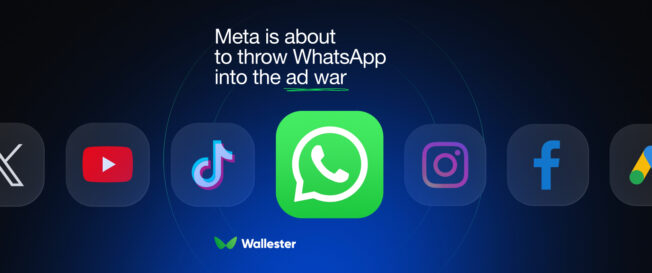Money management has changed significantly since tech companies entered the banking world. As we navigate 2025, marketing teams in this field face new challenges and opportunities. From clever AI tools to blockchain apps, tech-focused financial companies are finding creative ways to engage with customers and stay ahead of their rivals. Let’s look at what is happening in fintech marketing today and which tactics are working best right now.
What is the fintech marketing landscape in 2025?
The fintech world has undergone significant changes in recent years, growing rapidly despite economic uncertainty. Marketing in this field requires special approaches that address both technological innovations and customers’ concerns about trust simultaneously. As more companies join the race, they must find clever ways to explain complex financial products while addressing growing privacy concerns.
The rising role of fintech
Financial technology has gone from being a niche that operated outside the traditional industry to becoming a core part of how our economy works. These companies now help billions of people worldwide, handling everything from daily digital payments to complex wealth planning tools. Old-style banking has been updated as tech firms introduce easier and quicker options that tech-savvy customers love.
The busy money game has gotten more crowded, with big names and newcomers fighting for customers. This battle has sped up tech progress while pushing marketing teams to create more unique brand stories. Banks that once saw startups as enemies now actively look for team-ups or buy promising new ventures to boost their digital tools.
Recent patterns suggest that the next wave of growth will come from focused solutions that fix specific customer problems, rather than broad changes. This focus gives marketing teams clear groups to target with custom messages.
Why do fintech marketing trends matter?
Keeping up with fintech marketing shifts gives companies key advantages as things change quickly. What customers expect from financial institutions and services has totally changed, with ease, speed, and personal touches now seen as basic needs rather than extra perks.
Marketing plans that worked just months ago may already be losing their power as customer habits continue to change. Fintech businesses that don’t update their communication strategy risk looking outdated, even if they have technically better products.
The strict rules around money services add another layer of complexity. Marketers must balance eye-catching messages with tight regulatory compliance rules. Understanding emerging regulations helps marketers create campaigns that are both compliant and connect with their target audiences.
Perhaps most importantly, watching the fintech industry shift helps companies spot untapped possibilities before rivals do. Whether that means reaching overlooked groups through banking access projects or using new tech to create fresh customer moments, trend-aware marketers help their companies gain crucial first-mover benefits.
Further Reading: Move Faster, Spend Smarter: 5 Real Stories from Companies Using Wallester
Top fintech marketing trends for 2025
1. Personalisation and targeted campaigns
Personal touches have gone far beyond just using customers’ names in mass email campaigns. Today’s fintech marketing uses data-driven insights to create deeply customised moments. Companies study payment patterns, app usage, and other customer behaviour signals to offer ideally timed product suggestions.
This deep personalisation covers communication channels, message timing, and content types. Some fintech firms now tailor their entire user journey based on personal money goals and risk comfort levels. These customised moments build customer satisfaction and trust and noticeably improve conversion numbers.
The most successful targeted campaigns mix demographic facts with real-time behaviour triggers. For example, a banking app might spot a pattern of cash shortages before payday and carefully introduce a relevant short-term borrowing option. This contextual marketing feels helpful rather than pushy when done thoughtfully.
2. Live streaming and video marketing
Video content has become essential to fintech marketing plans, with live streaming being particularly good at building genuine connections. Money service providers now regularly host live teaching sessions, product demos, and question-and-answer events that make complex money concepts easier to grasp.
These video-based approaches work well for reaching younger people who prefer watching information rather than reading it. Short videos explaining financial products in plain language have been very successful on platforms like TikTok and Instagram.
Industry front-runners increasingly use video to add personality to their brands and showcase their knowledge. By putting faces to previously faceless financial services, these companies build trust and emotional links with audiences traditionally wary of banks.
3. More voice search presence in financial technologies
Voice search optimisation has become more important as more customers rely on voice assistants for money information. Forward-thinking fintech marketers now structure content to match the conversational nature of voice questions, which tend to be longer and more question-oriented than typed searches.
Money apps are increasingly adding voice features for everything from checking balances to starting payments. This technology appeals to users who want hands-free options while driving or multitasking, as well as improving access for those with visual impairments or limited hand mobility.
Marketing teams are adapting by creating FAQ-style content that directly answers common voice questions and adding conversational phrases into their search optimisation strategies. Some fintech brands have even created distinctive sound signatures that boost brand recognition across voice-activated platforms.
4. Improved customer service with chatbots and conversational AI
AI-powered customer service tools have reached impressive levels of capability, with the latest talking AI systems able to handle complex financial questions. These systems now manage everything from routine account questions to personalised product tips, lifting customer happiness while cutting operational costs.
The integration of chatbots with financial services creates smooth experiences where customers can solve problems or complete financial transactions without leaving the message interface. Leading fintech companies use chatbots that know when to hand off interactions to human agents, creating layered support systems that balance efficiency and service quality.
Marketing teams use these conversation channels to gather valuable customer data and identify areas for improvement. The insights from these chats inform product development and campaign improvements, creating a feedback loop that constantly boosts both offerings and messaging.

5. Affiliate and influencer marketing
Fintech companies are increasingly working with influencers who can translate complex financial concepts into relatable content. Unlike old-style celebrity endorsements, today’s fintech influencer marketing focuses on honest education and transparency. Money-focused content creators with dedicated followings are often more effective than mainstream celebrities.
The best influencer partnerships feature creators who genuinely use and believe in the products they promote. Their honest testimonials help address customer worries about switching money service providers or trying unfamiliar technologies. These team-ups work particularly well for reaching demographic groups that have been historically overlooked by traditional financial institutions.
Affiliate marketing programs have also evolved, with smart tracking and attribution models that reward partners for bringing qualified leads. These performance-based arrangements align marketing spending with actual business results, making them increasingly attractive during uncertain economic times.
6. Social media as a primary marketing channel
Social platforms have changed from backup channels to primary battlegrounds for fintech customer share. Companies now develop platform-specific strategies that use each network’s unique features and audience traits.
LinkedIn serves as a hub for thought leadership content and business-to-business fintech marketing, while Instagram and TikTok excel at reaching younger consumers with educational content disguised as entertainment. Twitter provides a real-time channel for customer service and commentary, helping brands show responsiveness and industry expertise.
The disappearing content formats made popular by Snapchat and Instagram Stories work particularly well for time-sensitive offers and product launches. These limited-time messages create a sense of urgency and drive immediate action, valuable traits for promotional campaigns.
Further Reading: What Are the Best Virtual Cards for Ad Spend?
7. More focus on content marketing
Content marketing remains fundamental to fintech marketing, with a growing emphasis on educational materials that address specific financial challenges. High-value content positions companies as trusted advisors rather than mere service providers, a significant distinction in an industry where trust directly affects conversion rates.
Money topics often intimidate consumers, making accessible educational content particularly valuable. Successful fintech content strategies incorporate multiple formats, including articles, podcasts, graphics, and interactive tools that cater to different learning preferences. These resources often achieve high engagement even without explicit product promotion.
Search optimisation tailored to money questions helps ensure this content reaches consumers actively seeking solutions. Companies that consistently publish high-quality, keyword-optimised information establish themselves as authoritative sources, benefiting from sustained organic traffic growth.
8. A greater emphasis on data security and privacy
With heightened customer worries about data protection, security messaging has moved from technical footnotes to central selling points. Fintech companies now prominently feature their security measures and privacy policies in marketing materials, recognising that transparent data practices directly influence buying decisions.
The most effective security-focused marketing strikes a balance between reassurance and alarm. Rather than exploiting fears, successful campaigns emphasise how strong protections work quietly to safeguard sensitive financial information without complicating the user experience.
Rule changes like GDPR and CCPA have accelerated this trend, with compliant data practices becoming competitive advantages rather than merely legal requirements. Companies that exceed minimum compliance standards often highlight these additional protections in their marketing messages.
9. Mobile-first marketing approach
Mobile devices now serve as the main access point for financial services, driving fintech companies to adopt comprehensive mobile-first strategies. These approaches prioritise smooth experiences on smaller screens rather than treating mobile optimisation as an afterthought.
Progressive fintech marketers recognise that mobile users have different interaction patterns and attention spans compared to desktop users. They develop concise messages with immediate value propositions, understanding that mobile consumers often make decisions while multitasking or during brief downtime moments.
Location-based marketing features prominently in these mobile strategies, with geo-targeted offers that activate when users enter specific areas, such as shopping districts or competitor locations. These contextual messages achieve significantly higher engagement rates than generic promotions.
10. BNPL in fintech marketing
Buy Now, Pay Later (BNPL) services have expanded from retail partnerships into broader financial offerings, creating distinct marketing challenges and opportunities. These services appeal particularly to younger consumers seeking payment flexibility without traditional credit arrangements.
Marketing for BNPL solutions emphasises transparency and control, directly addressing common concerns about hidden fees or debt accumulation. Successful campaigns highlight interest-free instalment options and integrate seamlessly with e-commerce platforms to minimise purchase friction.
Forward-thinking fintech companies now combine BNPL offerings with money education resources, helping users make responsible decisions while building loyalty through value-added content. This approach addresses regulatory concerns while differentiating itself from competitors that focus solely on transaction facilitation.
11. Taking advantage of advanced data analytics
Advanced data analysis capabilities allow fintech marketers to move beyond basic demographic targeting toward predictive approaches that anticipate customer needs. These systems identify subtle patterns that indicate life changes or emerging financial needs, creating opportunities for timely and relevant outreach.
Sentiment analysis tools monitor social media and review platforms to detect shifting consumer perceptions, allowing companies to address consumer concerns before they impact broader audience sentiment. These insights are valuable during product launches or following service changes.
The combination of predictive analytics with automation creates marketing systems that continuously optimise themselves based on performance data. These self-improving campaigns progressively increase efficiency, directing resources toward the highest-performing channels and messages.
12. Implementing AI and automation
Artificial intelligence now powers numerous aspects of the competitive fintech market, from content personalisation to campaign optimisation. Machine learning algorithms analyse vast datasets to identify subtle patterns human marketers might miss, revealing unexpected audience segments or messaging opportunities.
Automation handles routine marketing tasks, such as email sequencing and social media scheduling, freeing human team members to focus on creative development and strategy. The most sophisticated systems adjust messaging based on recipient actions, creating dynamic campaigns that respond to user behaviour in real time.
AI-driven fraud detection systems provide both practical security benefits and compelling marketing messages. Companies highlight how these emerging technologies protect customers while minimising friction, addressing the seemingly contradictory consumer demands for both convenience and security.
13. Incorporating blockchain and cryptocurrencies into marketing
Blockchain technologies have expanded beyond cryptocurrency applications into broader fintech marketing strategies. Companies leverage blockchain for transparent loyalty programs where points function as tokenised assets that can be tracked, transferred, or traded.
Some innovative fintech industry players offer cryptocurrency rewards for specific customer actions, simultaneously incentivising desired consumer behaviours and introducing users to digital assets in a low-risk context. These programs serve both acquisition and educational purposes.
For companies directly involved in cryptocurrency services, marketing is increasingly focused on practical applications rather than speculative investments. Campaign messaging highlights everyday uses, such as cross-border payments or small transactions, making these technologies feel more accessible to mainstream users.
14. AR and VR technologies for creating engaging experiences
Augmented reality (AR) and virtual reality (VR) create immersive experiences that help visualise abstract money concepts. Some wealth planning platforms now offer virtual portfolio visualisations where users can literally “walk through” their investments, making asset allocation more intuitive.
AR features in digital banking apps allow users to point their phones at physical locations and see relevant money information overlaid on the real world. These features might display property prices while house hunting or show spending history when the user points at a restaurant or store they have previously visited.
VR technologies show particular promise for money education, creating consequence-free environments where users can practice investment strategies or experience simulated market conditions. These game-like learning tools improve information retention compared to traditional educational materials.

What strategies for success in fintech marketing to choose?
Develop a comprehensive content plan
Successful digital marketing relies on content strategies that address the entire customer journey. Begin by mapping content needs across awareness, consideration, decision, and retention phases, identifying knowledge gaps and questions at each stage.
Focus on creating cornerstone content pieces that address fundamental questions in your niche. These comprehensive resources attract organic traffic while establishing authority. Supplement these major pieces with regular updates reflecting changes and emerging consumer questions.
Content collaborations with adjacent but non-competing financial services offer practical ways to reach broader audiences. For example, accounting software companies and payment processors might create joint resources that serve their overlapping customer bases while showcasing each product’s complementary strengths.
Create a strong brand identity
In the crowded fintech arena, a distinctive brand identity helps companies stand out from functionally similar competitors. Effective branding communicates core values and differentiators through consistent visual elements, a clear messaging tone, and seamless customer experience touchpoints.
Successful fintech brands often focus on a single compelling promise rather than trying to be everything to everyone. This focused positioning makes marketing messages more memorable and helps teams make consistent decisions about product development and communication strategies.
The most resonant fintech brands build identities around solving specific pain points rather than simply promoting technology features. Whether addressing banking access challenges or simplifying complex investment processes, these purpose-driven brands connect emotionally with users who seek specific solutions.
Be responsive and agile
Conditions and consumer preferences change rapidly in the fintech sector, requiring marketing teams to maintain flexible data-driven strategies. Establish systems for continuous testing and optimisation rather than setting annual plans that cannot accommodate emerging opportunities.
Dedicate resources to monitoring competitor activities and key developments in the fintech industry. This ongoing intelligence gathering helps identify strategic gaps and anticipate shifts before they affect business results. Teams that detect key trends early gain valuable implementation advantages.
Create streamlined approval processes for time-sensitive marketing opportunities. In fast-moving sectors, the ability to quickly capitalise on relevant events or trending topics often proves more valuable than perfectly polished campaigns that arrive too late.
Improve customer engagement and support
Customer engagement strategies should extend beyond the initial sale to foster ongoing relationships. Develop segmented communication plans that recognise different usage patterns and provide relevant value at appropriate intervals.
Integrate marketing and support functions to create consistent experiences across all customer touchpoints. When support teams understand campaign promises and marketing teams understand common customer challenges, both groups can deliver more aligned messages.
Implement regular feedback collection mechanisms and demonstrate responsiveness to user suggestions. Customers who see their input reflected in product improvements become powerful advocates, often generating word-of-mouth marketing more effective than paid promotions.
Further Reading: Embedded Finance: Not Just For Fintechs
Stay ahead of the fintech trends: partner with Wallester
To remain competitive in the fintech market demands reliable, scalable infrastructure and a clear path to launch. That’s where Wallester comes in. As a licensed Visa card issuer and payment platform provider, Wallester offers ready-made solutions that allow fintechs to launch new financial products quickly, test go-to-market strategies with minimal overhead, and scale with confidence.
Wallester’s White-Label solution gives partners the ability to issue physical and virtual cards under their brand, including debit, credit, prepaid, and Buy Now Pay Later (BNPL) options. These cards can be fully integrated into apps and services, helping marketing teams create unique user experiences that stand out in a crowded market.
In addition to core issuing services, Wallester provides built-in support for:
- Real-time analytics – to track user behaviour, test campaigns, and optimise conversion funnels.
- Custom card design tools – allowing brands to maintain visual consistency across marketing and product materials.
- Full API access – giving developers and marketing teams complete control over customer onboarding, card lifecycle, and transactional data.
- Multi-currency support and FX tools – essential for fintechs operating across regions or targeting cross-border users.
- KYC and AML compliance automation – helping brands stay ahead of regulatory requirements without slowing down growth.
For companies looking to reduce time to market, avoid the cost of building in-house infrastructure, or enter new segments like buy now, pay later (BNPL) or embedded finance, Wallester offers a modern, flexible solution backed by deep industry expertise. Fintechs partnering with Wallester can focus their energy on sustainable growth and differentiation, while the platform handles the complex payment mechanics and regulatory burden.
Try it now. From startups testing product-market fit to established firms adding new revenue streams, Wallester is helping marketing and product teams execute more quickly, reach new users, and stay ahead of what’s next in financial technology.


